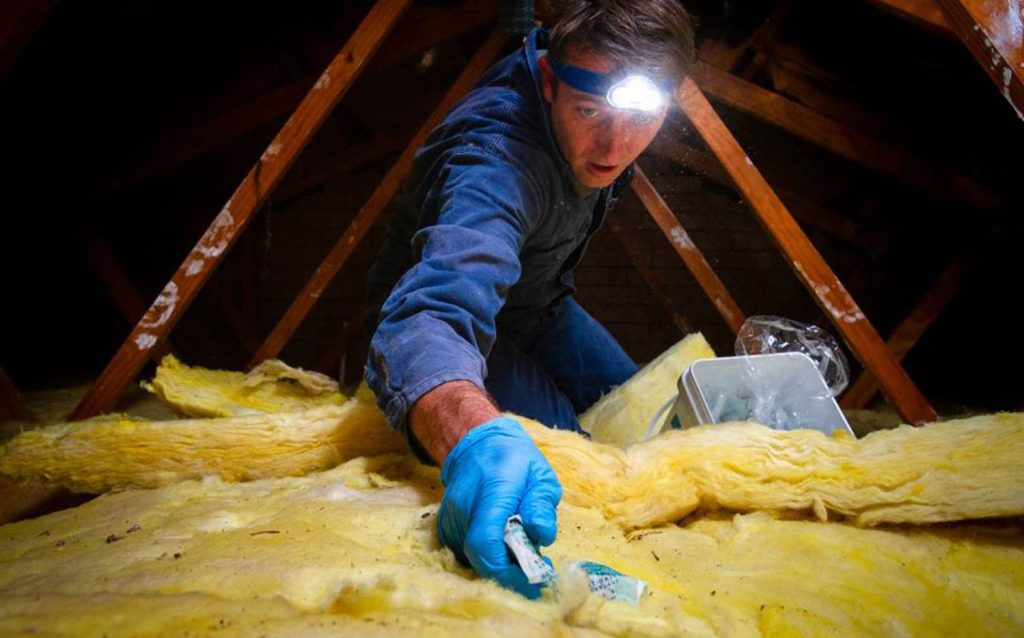
Pest control mice in Canberra
May 2021
Pest controller David Wolstencroft baits a Scullin home infested with mice.


In the pandemic, it was toilet paper; in the coming mouse plague, it’s bait stations.
Peter Sakley, a 30-year veteran of the pest control industry and whose company Precision Pest Control operates out of Canberra and into the southern NSW regional area, says that what is being seen now to the west of the ACT may be a portent for what could be expected in and around the city soon.
Hardware stores and supermarkets throughout the ACT are selling out of baits and traps in hours as the rodent infestation sweeping in from the west of NSW begins to gnaw its way into homes across the territory.
Shelves were bare of every single variety of mouse trap and bait in several hardware stores visited by The Canberra Times this week, with staff at Bunnings unable to keep up with demand.
As one staff member said, assessing the rows and rows of empty shelves: “it’s just like the rush on toilet paper during the [COVID] lockdown”.
“The truck comes in Thursday night or Friday morning, we re-stock the shelves that morning and by Sunday morning it’s all gone again,” he said.
Starting with far-western NSW and the Riverina, the mouse plague has begun its march eastward. In towns just to the west of Canberra such as Tumut, Adelong and Tarcutta, the mice are crawling through houses, getting into beds, nesting in clothing and chewing their way through pantry stores. Most recently, reports are coming in of large mice numbers seen in Murrumbateman, and outer Canberra suburbs such as Holt.
Bunnings shelves completely stripped of all rodent baits and traps.


As the ACT falls ever deeper into the grip of a sub-zero winter, conventional wisdom suggests that the numbers will subside.
Not so, say pest experts – it’s those nice, warm homes which will become more attractive to the rodents as winter begins to bite.
Mr Sakley says the current plague numbers are all field mice “generally about the size of your thumb”.
They have bred profusely, in their tens of thousands, in the aftermath of the drought-breaking rain which followed the terrible bushfire season of 2019-20 and the growth which followed – some of it preserved in carefully-harboured grain stores – has provided them with the ample food sources to breed, breed and breed again.
NSW farmers are still battling a mouse plague that’s caused havoc with crops and livelihoods.
“It’s not what people want to hear but what is likely to happen now, as the weather gets colder, is rodents will move indoors, into roof spaces, wall and floor cavities – anywhere where there’s warmth and food sources,” Mr. Sakley said.
What people need to look for in the ACT are early signs which begin to manifest externally.
“Check your veggie patch for signs that there are things nibbling away, and check your garden shed for activity because they are generally the first signs that the mice are working their way toward your house.” he said.
“These mice are very small so any small crumbs of food will provide sustenance. If you see the tiny droppings about, then that’s the giveaway that they are already inside your house.
“Mice always look for places which provide warmth, food and protection from predators.”
The mouse plague has reached such proportions that the NSW government has developed a $50 million support package for farmers, small businesses and households.
NSW households can claim bait rebates of up to $500 and small businesses up to $1000.
Mice control “workshops” are being held by CSIRO researcher Steve Henry to advise NSW farmers on strategies, and a highly potent, commercial-grade rodenticide called bromadiolone is being made available to areas where the infestations are most intense.
Mr Sakley said that for the householder who may have pets or young children, bait stations are the safest control alternative – if you can find them. “We have been busy working on this problem and our suppliers are now reaching out to their Queensland suppliers to keep us stocked,” he said.
If there’s no bait stations to be found, one of the old-fashioned remedies for keeping mice out of your bed linen is to put the bedposts in buckets of water.
This page content is a copy of an article that originally appeared in The Canberra Times on 20 May 2021. The original article can be viewed here: www.canberratimes.com.au
Think you may have a mouse problem? Want to know the signs of rodents – the signs of rats and mice – to look out for?
